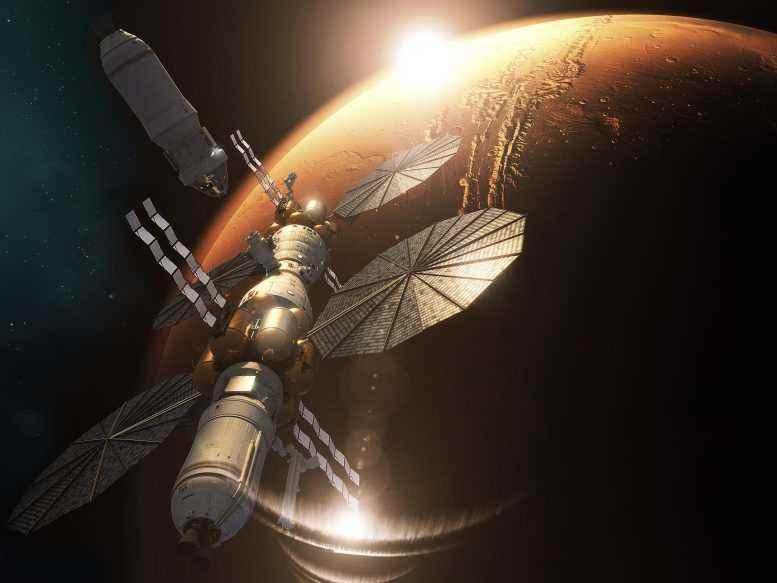Güneş Sistemi’nden ayrılan bir lazer yelkenli uzay aracı sürüsü. Kredi bilgileri: Adrian Mann
<span class="glossaryLink" aria-describedby="tt" data-cmtooltip="
” data-gt-translate-attributes=”[{” attribute=””>NASA and China plan to mount crewed missions to Mars in the next decade. While this represents a tremendous leap in terms of space exploration, it also presents significant logistical and technological challenges. For starters, missions can only launch for Mars every 26 months when our two planets are at the closest points in their orbit to each other (during an “Opposition“). Using current technology, it would take six to nine months to transit from Earth to Mars.
Even with nuclear-thermal or nuclear-electric propulsion (NTP/NEP), a one-way transit could take 100 days to reach Mars. However, a team of researchers from Montreal’s McGill University assessed the potential of a laser-thermal propulsion system. According to their study, a spacecraft that relies on a novel propulsion system – where lasers are used to heat hydrogen fuel – could reduce transit times to Mars to just 45 days!
The research was led by Emmanuel Duplay, a McGill graduate and current MSc Aerospace Engineering student at TU Delft. He was joined by Associate Professor Andrew Higgins and multiple researchers with the Department of Mechanical Engineering at McGill University. Their study, titled “Design of a rapid transit to Mars mission using laser-thermal propulsion,” was recently submitted to the journal Astronomy & Astronomy.

Artist’s impression of a directed-energy propulsion laser sail in action. Credit: Q. Zhang/deepspace.ucsb.edu
In recent years, directed-energy (DE) propulsion has been the subject of considerable research and interest. Examples include the Starlight program – also known as the Directed Energy Propulsion for Interstellar Exploration (DEEP-IN) and Directed Energy Interstellar Studies (DEIS) programs – developed by Prof. Phillip Lubin and the UCSB Experimental Cosmology Group (ECG). As part of NASA-funded research that began in 2009, these programs aim to adapt large-scale DE applications for interstellar missions.
There’s also Breakthrough Starshot and Project Dragonfly, both of which emerged from a design study hosted by the Initiative for Interstellar Studies (i4iS) in 2013. These concepts call for a gigawatt-power laser array to accelerate a lightsail and a small spacecraft to a fraction of the speed of light (aka. relativistic speeds) to reach nearby star systems in decades, rather than centuries or millennia.
But whereas these concepts are interstellar in focus, Duplay and his colleagues explored the possibility of an interplanetary concept. As Duplay explained to Universe Today via email:
“The ultimate application of directed-energy propulsion would be to propel a lightsail to the stars for true interstellar travel, a possibility that motivated our team that did this study. We were interested in how the same laser technology could be used for rapid transit in the solar system, which will hopefully be a nearer-term steppingstone that can demonstrate the technology.”

Project Starshot, an initiative sponsored by the Breakthrough Foundation, is intended to be humanity’s first interstellar voyage. Credit: breakthroughinitiatives.org
Aside from laser sail propulsion, DE is being explored for several other space exploration applications. This includes power beaming to and from spacecraft and permanently-shadowed habitats (e.g., the Artemis Program), communications, asteroid defense, and the search for possible technosignatures. There’s also a concept for a laser-electric spacecraft being investigated by NASA and as part of a collaborative study between the UCSB ECG and MIT.
For this application, lasers are used to deliver power to photovoltaic arrays on a spacecraft, which is converted to electricity to power a Hall-Effect Thruster (ion engine). This idea is similar to a nuclear-electric propulsion (NEP) system, where a laser array takes the place of a nuclear reactor. As Duplay explained, their concept is related but different:
“Our approach is complimentary to these concepts, in that it uses the same phased-array laser concept, but would use a much more intense laser flux on the spacecraft to directly heat propellant, similar to a giant steam kettle. This permits the spacecraft to accelerate rapidly while it is still near earth, so the laser does not need to focus as far into space.
“Our spacecraft is like a dragster that accelerates very quickly while still near earth. We believe we can even use the same laser-powered rocket engine to bring the booster back into earth orbit, after it has thrown the main vehicle to Mars, enabling it to be quickly recycled for the next launch.”

An artist’s concept for a nuclear rocket that would facilitate missions to Mars. Credit: Rolls-Royce
In this respect, the concept proposed by Duplay and his colleagues is akin to a nuclear-thermal propulsion (NTP) system, where the laser has taken the place of a nuclear reactor. In addition to DE and hydrogen propellant, the mission architecture for a laser-thermal spacecraft includes several technologies from other architectures. As Duplay indicated, they include:
“[A]Tek bir optik eleman olarak hareket eden fiber optik lazer ışınları, lazer ışınını uzay aracına ulaştığında ısıtma odasına odaklamak için kullanılabilecek şişirilebilir uzay yapıları ve uzay aracına izin veren yüksek sıcaklıktaki malzemelerin geliştirilmesi. varışta Mars atmosferine karşı kırın. ”
Bu son unsur, Mars’ta uzay aracını Mars’a ulaştığında yavaşlatacak bir lazer dizisi olmadığı için önemlidir. “Şişirilebilir reflektör, diğer yönlendirilmiş enerji mimarilerinin bir anahtarıdır: son derece yansıtıcı olacak şekilde tasarlanmıştır, birim alan başına bir fotovoltaik panelden daha büyük bir lazer gücünü sürdürebilir, bu görevi lazer-elektrik ile karşılaştırıldığında mütevazı bir lazer dizisi boyutuyla mümkün kılar. tahrik,” diye ekledi Duplay.
Bu unsurları birleştirerek, bir lazer-termal roket, Mars’a altı hafta kadar kısa bir sürede çok hızlı geçişler sağlayabilir – bu, daha önce yalnızca nükleer enerjili roket motorlarıyla mümkün olduğu düşünülen bir şey. En acil yararı, radyasyona ve mikro yerçekimine uzun süre maruz kalma gibi derin uzay geçişlerinin tehlikelerine bir çözüm sunmasıdır.

Sanatçının Mars’ın yörüngesindeki Mars Ana Kampı izlenimi. Mars misyonları başladığında, en büyük risklerden biri uzay radyasyonunun oluşturduğu risk olacaktır. Kredi bilgileri: Lockheed Martin
Aynı zamanda, Duplay, söz konusu teknolojilerin çoğu son teknoloji olduğundan ve henüz test edilmediğinden, görevin bazı engeller sunduğunu söylüyor:
“Lazer ısıtma odası muhtemelen en önemli zorluktur: Lazer ışını tarafından 10.000 K’den daha yüksek sıcaklıklara ısıtılırken aynı zamanda odanın duvarlarını serin tuttuğu için itici gazımız olan hidrojen gazını kontrol altına alabilir miyiz? Modellerimiz bunun mümkün olduğunu söylüyor, ancak tam ölçekli deneysel testler şu anda mümkün değil çünkü ihtiyaç duyulan 100 MW lazerleri henüz üretmedik.”
Bu önerilen görev mimarisindeki teknolojinin çoğu – ve diğer benzer öneriler – hala teori ve geliştirme aşamasında olsa da, potansiyelleri hakkında hiç şüphe yok. Mars’a gitmek için gereken süreyi aylar yerine birkaç haftaya düşürmek, Mars misyonları için en büyük iki zorluğun üstesinden gelecek – lojistik ve sağlık konuları.
Ayrıca, Dünya ile Mars arasında hızlı bir geçiş sistemi kurmak, Dünya ile Mars arasında altyapı oluşturulmasını hızlandıracaktır. Bu, Lockheed Martin tarafından önerilen Mars Ana Kampı gibi, Mars yörüngesindeki Ağ Geçidi benzeri bir uzay istasyonunu ve ayrıca gelen uzay aracını yavaşlatmak için bir lazer dizisini içerebilir. Bu tesislerin varlığı, yüzeyde kalıcı bir insan varlığı yaratma planlarını da hızlandıracaktır. Profesör Higgins’in şu sonuca vardığı gibi:
“Emanuel’in önderlik ettiği 45 günlük Mars tasarım çalışması, Philip Lubin’in grubunun geliştirmekte olduğu aşamalı dizi lazer teknolojisinin diğer kısa vadeli uygulamalarını keşfederek motive edildi. Enerjiyi lazer aracılığıyla uzayın derinliklerine iletme yeteneği, tahrik ve güç için yıkıcı bir teknoloji olacaktır. Çalışmamız, cesaret verici görünen lazer termal yaklaşımını inceledi, ancak lazer teknolojisinin kendisi gerçek oyun değiştirici.
Orijinal olarak yayınlandı Bugün Evren.

